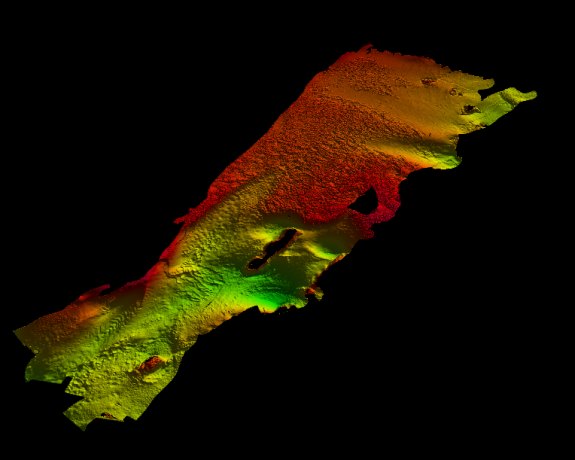Painting a Picture of Seagrass with Sound
Scientists use ocean physics to investigate why seagrass flourishes in an unexpected place.

In the tranquil August ocean swell, three scientists bob up and down aboard the Hakai Blue. The seven-meter-long vessel putts along in a methodical grid around a coastal area the size of 50 football fields. From a crow’s-eye view, they appear to be mowing a watery lawn (if the “mower” was floating eight meters above the grass). But rather than ineffectively landscaping, they’re mapping the extensive seagrass meadows below the surface of Choked Passage on the northern end of Calvert Island—and trying to figure out why seagrass is thriving in a surprising spot.
Knowing the limits of where seagrass can thrive is key to its recovery after substantial declines in this marine plant in the past decades. Seagrass meadows play a critical role on the coast as nurseries for fish and invertebrates and sinks for carbon. On the west coast of North America, this kind of seagrass—an eelgrass called Zostera marina—is often associated with calm bays, lagoons, and sheltered coves. If we limit research and restoration efforts to only calmer waters, we’d miss potential meadows and restrict where it could be restored.
While conditions are good for the scientists in August, Choked Passage is anything but calm throughout most of the year. Powerful currents fly between the open Pacific Ocean and the rough waters of Hakai Passage. Yet here are some of the largest eelgrass meadows in the area. In the unexpected, lies an opportunity for science.
For years, Hakai ecologists and collaborators have studied eelgrass in Choked Passage—how it grows, what creatures live there, and how the ecologically productive meadows are shrinking or expanding. In true Hakai fashion, questions lead to more questions, and disciplines get blurred and combined. Understanding the biology of this seagrass now requires a dive into ocean physics.
“The eelgrass changes quite a bit from year to year in where and how it grows,” says Keegan Paterson, a master’s student at the University of Victoria who is on her second research trip to the area. “We’re trying to figure out why by pairing the physical and biological data.”

On the back deck of the Hakai Blue, Paterson prepares scientific equipment for deployment. She inspects an instrument roughly the size of a five-gallon bucket, called an Acoustic Doppler Current Profiler, or ADCP, which measures ocean currents and how much sediment is clouding up the water. While those sensors describe conditions in the water, another piece of equipment is being prepped to sketch the sea bottom.
Inside the boat’s cabin, Hakai geospatial scientist Nick Viner toggles a dial on the multibeam sonar, a device that uses sound waves to map the seafloor.
“Multibeam is like a fish finder or a depth sounder on any boat,” says Viner. “But imagine you have 512 sounders and point them all at different angles.”
By combining sources of data collected by the ADCP, multibeam, and other instruments, patterns begin to emerge about the conditions where seagrass can grow in Choked Passage.
“If you draw contours or lines around where the multibeam identified seagrass, it follows the depth almost to a T,” says Viner. “Seagrass is picky.”
Picky though it might be, seagrass has a few tricks up its blades—its plasticity. Not in the made-of-petroleum products-kind of way. While seagrass is an oddity as a flowering plant that grows in the ocean, it’s unquestionably made of plant cells. When scientists say seagrass is plastic, they mean the plant can shapeshift depending on the conditions where it grows, and can adapt when conditions inevitably change. The length of its shoots, the robustness of its blades, the density of the meadow—these traits are all plastic. But there are trade-offs and limitations. Seagrass can’t just grow anywhere.

“Much of the research on seagrass, and especially seagrass hydrodynamics, comes from elsewhere,” says Margot Hessing-Lewis, an ecologist with the Hakai Institute. “So what are the limits where seagrass can grow on the west coast of North America? We don’t know yet.”
It seems as though the strong currents of Choked Passage push away cloudy water and allow more light to reach deeper. For seagrass to grow there, it must be robust enough to withstand getting swept away or broken while still getting enough energy from the sun to survive.
Back on the boat, Paterson leans over to untangle a sensor that was wrapped with a few stray seagrass blades. While her research is focused on physics and geomorphology—the water and sediment flow that make the meadows possible—she can’t help but marvel at the life that flourishes there.
“Choked Passage has changed how I see seagrass,” says Paterson.

